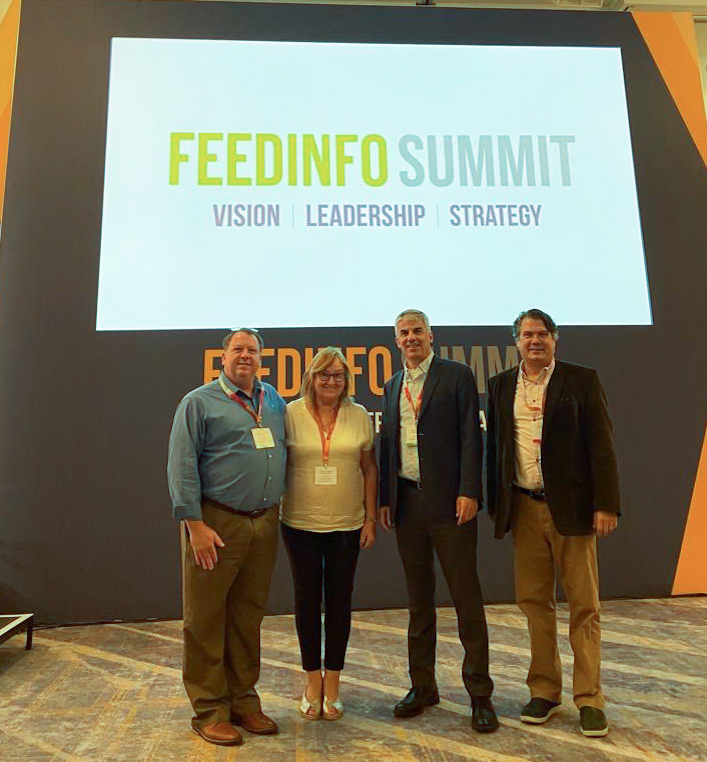Feedinfo Summit Reinforces Importance of Nutrient Value of U.S. Soy for Animal Feed
- Category:
- Market Access

By Brad Doyle, farmer and Eagle Seed Company, Weiner, Arkansas, and American Soybean Association director
The Feedinfo Summit provides deep insight into the global animal feed industry. I attended the 2023 summit in Vienna, Austria, in September with USSEC, a major event sponsor. As a U.S. soybean farmer and breeder, I learned about animal nutrition and care, deepening my understanding of the role of soybean meal from U.S. Soy in the industry.
“Soybean meal delivers essential amino acids like digestible lysine and methionine, along with energy and phosphorus,” explains Tom D’Alfonso, Ph.D., animal and aquaculture director for USSEC. “It has high palatability and digestibility for poultry, swine, fish, cattle, and more.”
The number of additives that comprise animal feed surprised me. They are much more than a mixture of corn or other grains with soybean meal. Regardless of species, feed often includes synthetic amino acids like methionine, lysin, and tryptophan. It also contains vitamins like A, E and B2 and minerals like phosphates or copper sulfate.
USSEC emphasizes the consistency and amino acid profile of soybean meal made from U.S. Soy because that impacts the type and amount of additives required for specific rations.
“The ultimate value of soybean meal for animal nutrition lies in more than just the crude protein it contains,” D’Alfonso says. “Feedinfo tracks the price, demand and regional availability of key amino acid, vitamin, and mineral feed additives. That information allows us to calculate the value of a more complete amino acid profile in soybean meal from U.S. Soy.”
China produces many synthetic amino acids, exporting their excess. Fewer additive manufacturers operate in the U.S., which also surprised me. However, it caused me to consider the overall quality and complete nutritional package of U.S. soybeans. Looking for ways to add to that nutritional package, through soybean breeding or additive manufacturing, could be an opportunity to add value to U.S. Soy.
Advances in Animal Care Impact Nutrition
I was pleased to learn about the volume of research dedicated to mitigating potential animal disease outreach. Improving animal health and preventing catastrophic disease helps both farmers and processors.
Some of that research links feed ingredients to their impact on animals’ immune systems and their abilities to fight disease and maintain health. Though it wasn’t featured at Feedinfo Summit, the soy checkoff funds this type of research.
“The idea of ‘food as medicine’ is gaining traction in human nutrition, but the concept applies in animal feed, as well,” D’Alfonso adds.
I was also fascinated by the uses for artificial intelligence in the animal industry. I discovered that cameras are being used to help artificial intelligence models learn animal behavior and temperature so that issues can be identified more quickly.
Market Trends
One presentation from a Feedinfo analyst shared the global market outlook. While the presentation focused on additives, the trends connected to primary feed ingredients like soybean meal, as well.
“Though soybean meal offers essential amino acids, synthetic amino acids are added for different species for optimum feed efficiency,” D’Alfonso explains. “Changes in additive demands, especially for amino acids, infer changes for soybean meal, as well.
Overall, supply and delivery timing for feed ingredients has improved globally as the supply chain has finally worked through many of the knots created during the global pandemic. However, global uncertainty has caused buyers to be hesitant and producers to be cautious. Current buying trends are subdued.
Yet, global consumption for many additives is expected to increase in the coming year, which bodes well for soybean meal demand. However, when the soybean meal cost increases, synthetics become more cost-effective.
Based on the many things I learned, I better understand the U.S. Soy emphasis on the quality of our soybeans and soybean meal. I can pay attention to my seed selection and agronomic practices’ impact on soy protein content and amino acid profile.
This story is partially funded by U.S. Soy farmers, their checkoff, and the soy value chain.
# # #